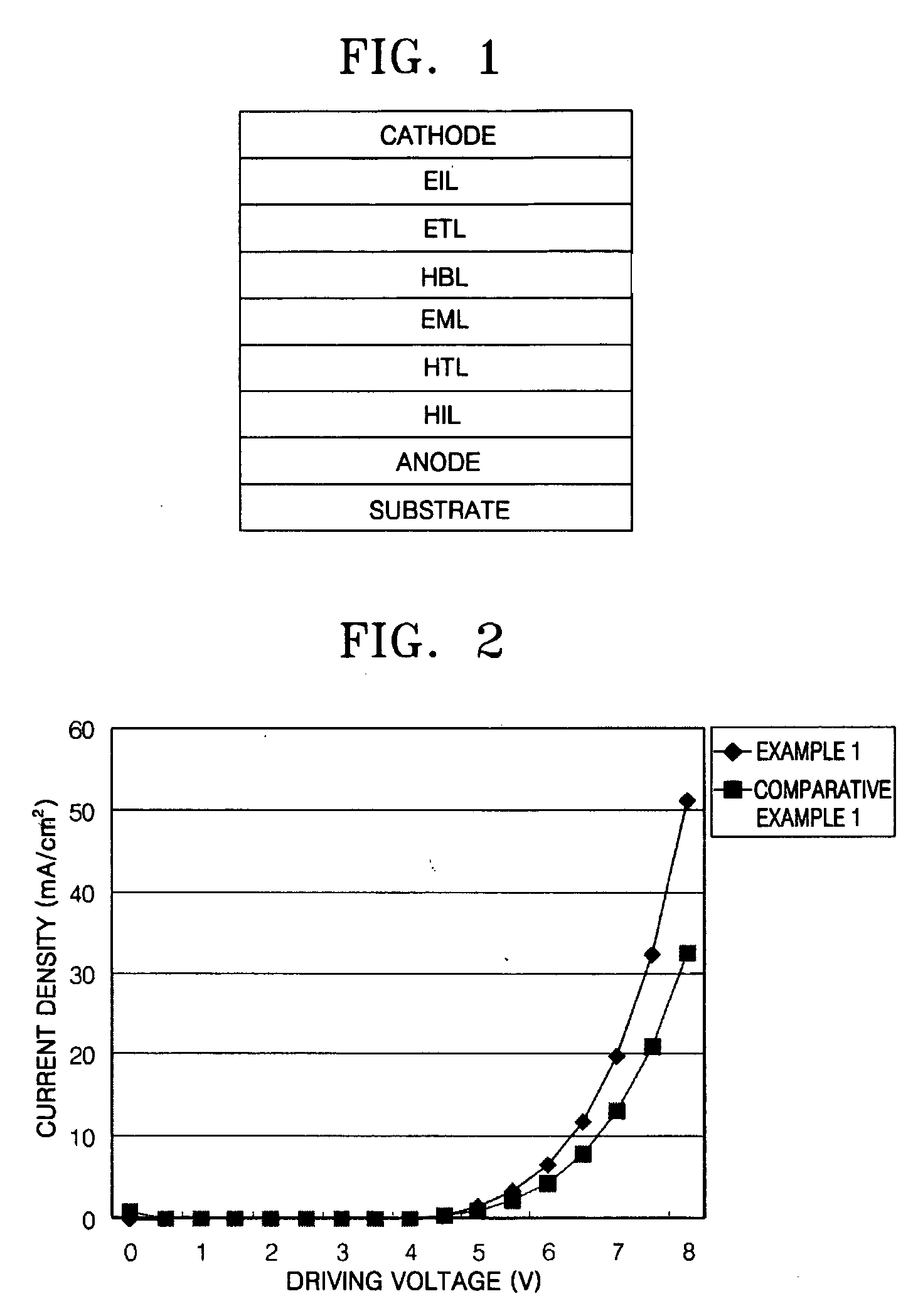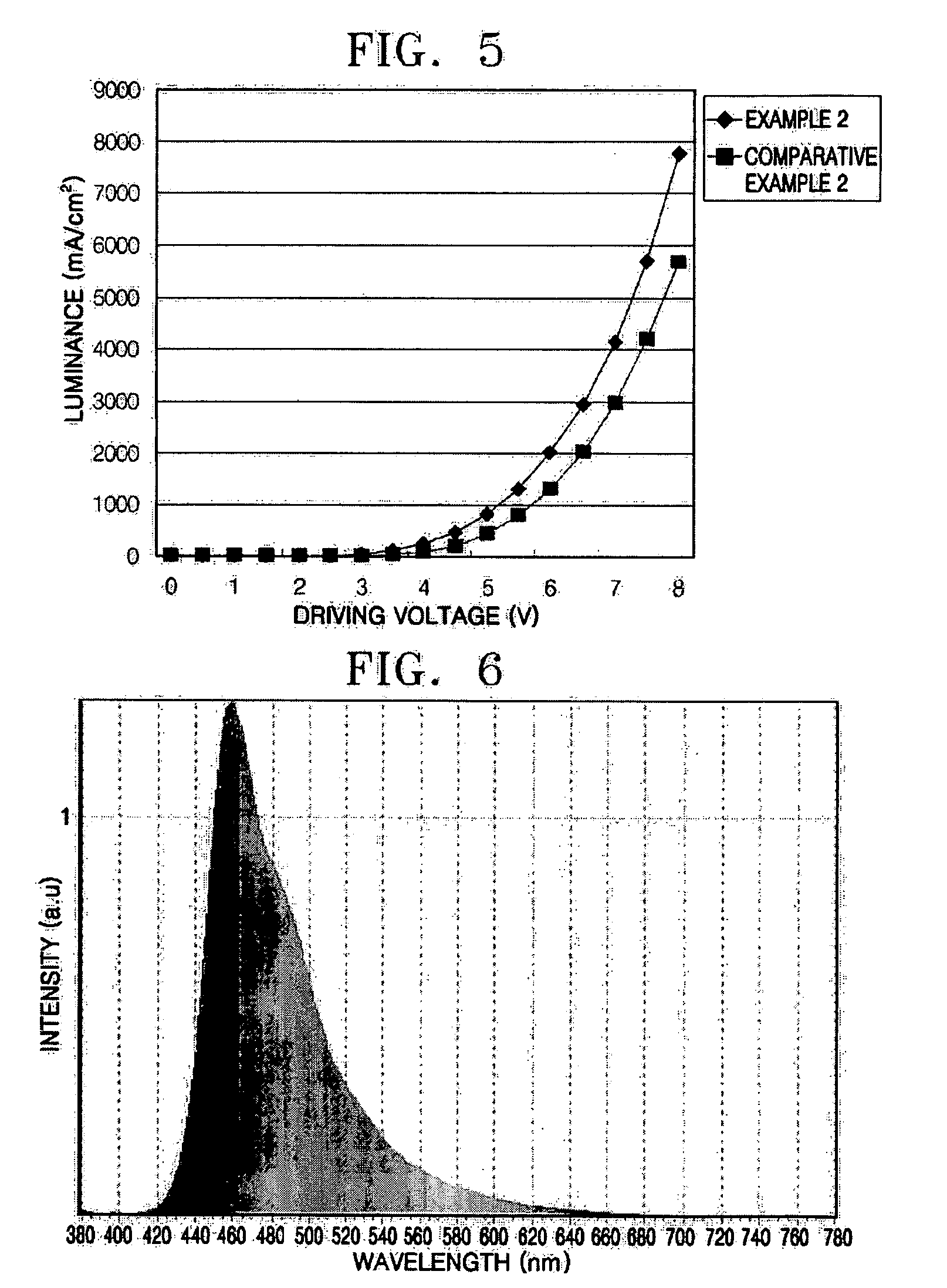Phenylcarbazole compounds and organic electroluminescence devices using the same
- Summary
- Abstract
- Description
- Claims
- Application Information
AI Technical Summary
Benefits of technology
Problems solved by technology
Method used
Image
Examples
synthesis example 1 (
Synthesis of Intermediates for Compound 2)
[0059] Compound 2 was synthesized through reaction pathways illustrated in reaction schemes (1) and (2) below.
Synthesis Of Intermediate A
[0060] 3.344 g (20 mmol) of carbazole was added to 40 mL of 1,3-dimethyl-3,4,5,6-tetrahydro-s(1H)-pyrimidinone, and CuI 0.761 g (4 mmol) of Cul, 11.057 g (80 mmol) of K2CO3, and 0.1 g (4 mmol) of 18-Crown-6 were added to the mixture. The resultant mixture was stirred at 170° C. for 20 hours, cooled to room temperature, and distilled under reduced pressure to remove the solvent. 100 mL of dichloromethane was added to dissolve the residue and washed several times with water. The washed dichloromethane layer was dried using MgSO4 and dried under reduced pressure to obtain a crude product. The crude product was purified using silica gel column chromatography and recrystallized using hexane to obtain 3.28 g of a solid intermediate A with a yield of 67%.
Synthesis Of Intermediate B
[0061] 2.433 g (10 mmol) of ...
synthesis example 2 (
Synthesis of Compound 2)
[0063] Compound 2, which is also represented by formula (5) in the detailed description and claims, was synthesized as follow.
[0064] 0.221 g (0.614 mmol) of intermediate C and 0.332 g (0.9 mmol) of intermediate B were dissolved in 10 mL of toluene. 0.144 g (1.5 mmol) of t-BuONa, 0.018 g (0.02 mmol) of Pd(dba)2, 0.004˜0.006 g (0.02˜0.03 mmol) of (t-Bu)3P were added to the solution and stirred at 90° C. for 6 hours. An organic layer was extracted from the reaction solution three times with 30 mL of ethyl ether each. The collected organic layer was dried using MgSO4, and the solvent was vaporized. The resulting residue was purified using silica gel column chromatography to obtain 0.236 g of Compound 2 with a yield of 64%. The structure of Compound 2 was identified by 1H-NMR: 1H-NMR (CDCl3, 400 MHz) δ (ppm) 8.05 (d, 2H), 8.03 (dd, 2H), 7.58 (m, 8H), 7.47 (m, 2H), 7.39 (m, 8H), 7.33 (dd, 2H), 7.24 (m, 2H), 6.94 (d, 2H).
example 1
[0065] An indium tin oxide (ITO) substrate (available from Coming Co. (New York, N.Y.)) having a resistance of 15 Ω / cm2 (1200 Å) was cut to a size of 50 mm×50 mm×0.7 mm and washed in isopropyl alcohol and pure water for 5 minutes each by ultrasonication and UV irradiation and using ozone. The washed substrate was loaded into a vacuum deposition apparatus. Initially, a hole injecting layer was formed of IDE 406 on the substrate to a thickness of 600 Å by vacuum deposition. Next, a hole transporting layer was formed on the hole injecting layer by depositing 4,4′-bis[N-(1-naphthyl)-N-phenylamino]biphenyl (NPB) in a vacuum to a thickness of 300 Å. After the formation of the hole transporting layer, an emitting layer was formed by simultaneously depositing on the hole transporting layer Compound 2 as a phosphorescent host and Ir(ppy)3 as a green phosphorescent dopant in a ratio of 93:7 to a thickness of 300 Å. A hole blocking layer was formed on the emitting layer by depositing Balq to a...
PUM
| Property | Measurement | Unit |
|---|---|---|
| Percent by mass | aaaaa | aaaaa |
| Percent by mass | aaaaa | aaaaa |
| Current density | aaaaa | aaaaa |
Abstract
Description
Claims
Application Information
 Login to View More
Login to View More - R&D
- Intellectual Property
- Life Sciences
- Materials
- Tech Scout
- Unparalleled Data Quality
- Higher Quality Content
- 60% Fewer Hallucinations
Browse by: Latest US Patents, China's latest patents, Technical Efficacy Thesaurus, Application Domain, Technology Topic, Popular Technical Reports.
© 2025 PatSnap. All rights reserved.Legal|Privacy policy|Modern Slavery Act Transparency Statement|Sitemap|About US| Contact US: help@patsnap.com



